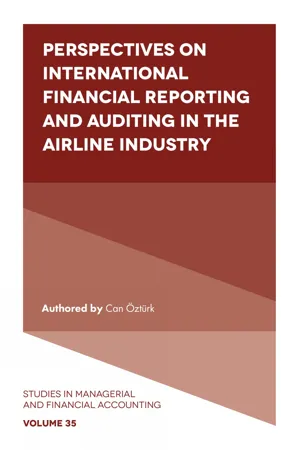
Perspectives on International Financial Reporting and Auditing in the Airline Industry
- 332 pages
- English
- ePUB (mobile friendly)
- Available on iOS & Android
Perspectives on International Financial Reporting and Auditing in the Airline Industry
About this book
Perspectives on International Financial Reporting and Auditing in the Airline Industry draws on the framework of financial reporting in the global airline industry for the year 2018 and focuses on the airline financial reporting based on International Financial Reporting Standards (IFRSs) and audit of airline financial reporting based on International Standards on Auditing (ISAs).
Contributing to the accounting policy choice debate from a sector-specific perspective, this book considers the existing policy choices under IFRSs, in order to observe the diversity, and comparability in the airline industry. It analyses the cumulative of effect of the adoption of IFRS 15 Revenue from Contracts with Customers and IFRS 16 Leases in the airline industry, including the case of Air France - KLM and it takes a picture of segment reporting in terms of diversity and comparability in the airline industry. Finally, it analyzes audit reports of airlines reporting under IFRS in terms of International Standards on Auditing, in terms of diversity of audit practices.
This book provides valuable insights into perspectives on international financial reporting and auditing in the airline industry and is essential reading for both researchers and professionals.
Frequently asked questions
- Essential is ideal for learners and professionals who enjoy exploring a wide range of subjects. Access the Essential Library with 800,000+ trusted titles and best-sellers across business, personal growth, and the humanities. Includes unlimited reading time and Standard Read Aloud voice.
- Complete: Perfect for advanced learners and researchers needing full, unrestricted access. Unlock 1.4M+ books across hundreds of subjects, including academic and specialized titles. The Complete Plan also includes advanced features like Premium Read Aloud and Research Assistant.
Please note we cannot support devices running on iOS 13 and Android 7 or earlier. Learn more about using the app.
Information
PART I
INTERNATIONAL FINANCIAL REPORTING
CHAPTER 1
OVERVIEW OF FINANCIAL REPORTING IN THE AIRLINE INDUSTRY
ABSTRACT
1. INTRODUCTION
Table of contents
- Cover
- Title
- Part I. International Financial Reporting
- Part II. International Auditing
- References
- Index